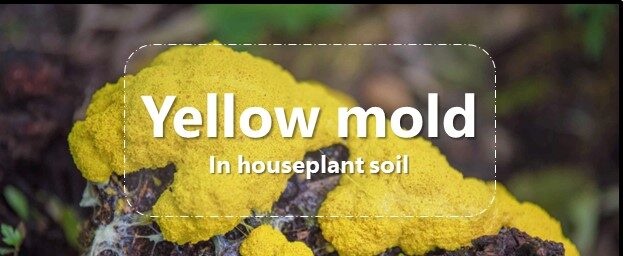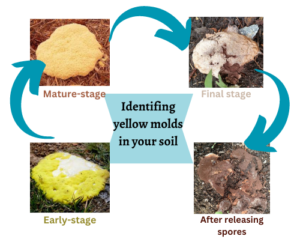If you spot a bubbly, slimy unsightly blotch in the soil of your indoor or outdoor plant and are concerned about “What is it? Is it dangerous? I tell you it is Fuligo Septica a yellow mold in houseplant soil. Except for using chemical fungicides, you can get rid of them by removing mold from the soil or repotting your potted plant. However, some points you must consider with this issue. Walk with me in this post to answer all your questions about the yellow mold in your houseplant soil and how to get rid of it.
 I’m a plant pathologist, a while ago, my friend called me: I’m a plant pathologist, a while ago, my friend called me:
–I see some things like “””Dog Vomit””” in my indoor plant soil 🙁 , what’s that? – Oh! Don’t worry! It’s “”” Dog Vomit Slime”””. 😀 – what? 😳 Yeah, it is a mold called Fuligo Septica or dog vomit slime (because of its disgusting look). However, it is also known as scrambled egg slime or flowers of tan. Let’s get going to know more about it. |
What Is the Yellow Mold in Houseplant Soil?
This part may be interesting only for the experts among you and not necessary to get rid of the yellow mold in potted plants’ soil. Hence you can jump to the next part; “How to identify yellow molds in soil?” or only read the “Your functional discovery” part.
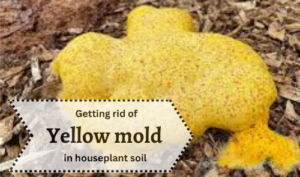
Yellow mold (Fuligo Septica) is not a plant or animal, it is a Slime mold (very simple organism without a brain, etc.) that is wrongly mentioned as a fungus due to its habits. Actually, Fuligo Septica is a member of the class Myxomycetes belonging to the Phylum of Amoebozoa and Domain of Eukaryota.
💡 Your Functional Discovery: Yellow mold is very close to seaweeds and Amoebas; Hence it loves moisture to grow and reproduce. It is a functional tip for its eradication.
How to Identify Yellow Molds in My Houseplant Soil? It is easy!
There is a basic law in plant pathology:
To succeed in controlling pests, diseases, molds and other annoying guests of your houseplants, the first step is trying to identify them correctly.
Yellow mold may have various appearances in the different stages of its lifecycle and you may spot it at different times. Hence, to make identification easy for you, you can find out its appearance at the different stages of its lifecycle (early stage, mature stage and final stage) in the following table:
| ➡ For those who don’t have enough time, the following table can help them to identify, troubleshoot and solve it quickly. I suggest you read the whole article to draw a sound plan for your problem. However, if you are busy, please notice the following table.
you can also ask me your questions below this page. I’ll answer you as soon as possible. Don’t forget to take a clear picture and send me to identify your exact problem. Thank you! |
||
|
Various stages of the lifecycle |
Appearance |
Recommends |
|
Early-stage: It is the beginning step of its infestation |
|
If you want to touch it, wear gloves and do it gently to avoid spreading its spores. |
|
Mature-stage: after a few days from the previous stage |
|
Same as above! |
|
Final stage: spreading the mold |
|
Be careful, in this stage its spores can be easily released and spread around your house. |
Why Does My Houseplant Soil Have Yellow Mold?
Most people after encountering a problem say: Why me? Answering this question will help you in controlling the yellow molds. Hence let’s get going to know how Fuligo Septica forms in your indoor plant soils.
There are three important keys to finding the answer:
- Yellow mold loves moisture and low light conditions (such as your bathroom).
- Its feed is decaying organic matter.
- Yellow mold spreads with thousands of very tiny spores.
Do you get it? When you increase the humidity and moisture in your houseplant soil by too much watering and leaving dead leaves and other organic material on the soil, the wandering spores of yellow molds will dwell in your indoor plant soil. Indeed, you invite them to your home! look at the following yellow mold infection triangle:
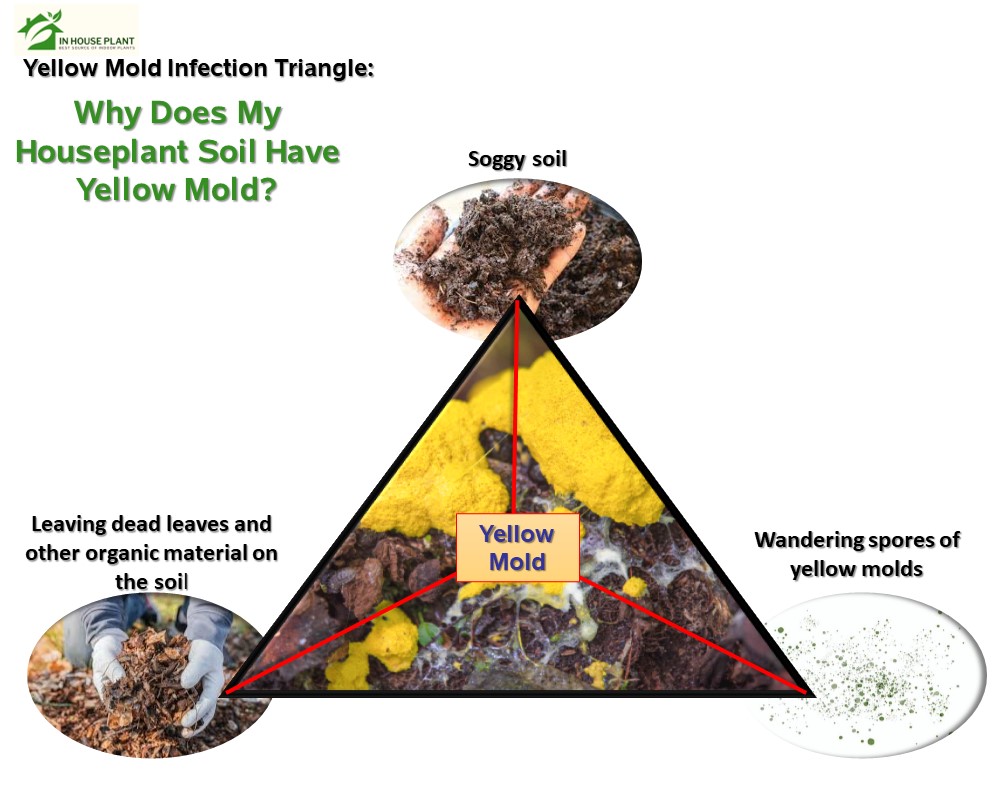
The above situation could be seen in your greenhouses too, when your ventilation is not adequate for mold.
Is Yellow Mold Dangerous?
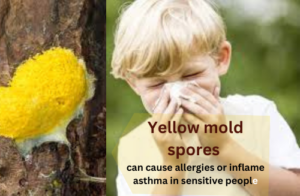
The good news is that yellow mold is not harmful to your houseplants, pets, and humans. But they can be trouble for people who have allergies. Yellow mold in the final stage of its life, when get dries out, releases thousands of dusty-like spores that can cause allergies or inflame asthma in sensitive people.
How to Get Rid of Yellow Mold in My House Plant Soil?
Now it is time to get rid of Fuligo Septica or dog vomit slime. you should remove them first and then prevent them from the next contaminations. Let’s get going.
The first step: remove yellow mold in your house plant soil
As you know, yellow mold isn’t dangerous for your houseplant. Hence if leave it alone, it will disappear a few days later. However, it will come back again stronger. Because it had spread its spores through your house before its death.
So, if you have little kids or pets and are considering eating yellow mold by them or if your family have an allergy to its spores, you should get rid of it. In the following, we have four remedies:
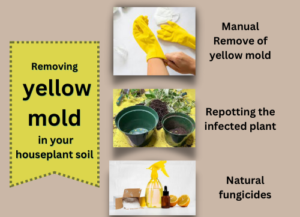
1- Manual Remove of yellow mold
I recommend waiting until your yellow mold turns white and its surface gets solid and cracked. The good news is that the yellow mold doesn’t have deep roots (indeed mycelia). Hence if you pick off the first quarter inch of soil (underneath the surface of the mold) and dispose of it in a plastic bag remove yellow mold with all spores and mycelia from the soil of your houseplant.
If you have any experience in getting rid of yellow mushrooms growing in your houseplant, you agree with me “Removing yellow mold is much easier than yellow mushrooms”.
2- Repotting the infected plant
In a heavy infection, it’s better to report your potted plant and replant it in uninfected soil. Note the following tips during repotting:
- Throw away the infected soil or sterilize it. you can extend and open it in a sunny place to completely dry out or spray it with a fungicide.
- You have to remove, wash, and spray with fungicide any decorative stones or shells in the pot before returning them to it.
3- Getting the help of natural fungicide
Using natural fungicides is a good idea for removing yellow molds. In the following you can find the four natural fungicides:
- Baking Soda: (1 tablespoon of baking soda + 2 litres of water)
Spray it on top of the mold. Its high pH level will stop the growth of mold.
- Vinegar:
you can spray pure vinegar (without adding water) because it is a weak acid. You should apply it for two days, after that, you can remove the killed mold.
- A mix of apple cider vinegar and Neem oil (weak apple cider vinegar + water+ a few drops of neem oil)
Use this wonderful fungicidal like the above.
- Cinnamon powder:
You can repel mold spores by sprinkling cinnamon powder on top of the soil.
Warning: some spores might have survived. Use a plastic bag for moving mold outside.
The second step: prevent of growing yellow mold in your house plant’s soil
If you removed it and want to prevent its reinfection, please note the following infographic.
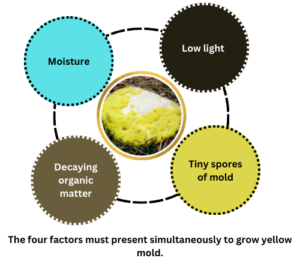
As you have seen in the above infographic, the four factors (rich soil, waterlogged and humid environment, low-light conditions and spores of yellow mold) must present simultaneously.
If you can cut the above chart by removing one of these factors you can get rid of them. In the following, some tips can help you prevent yellow mold growth.
1- Changing the conditions:
In the above infographic, the first three factors are related to the favorite environment of yellow mold. If you can change these conditions you can prevent it. for example:
- Drying the topsoil and reducing the moisture
- Remove hardwood and other rotting vegetation such as decomposing leaves, twigs, flowers, etc. from the potting soil. Yellow mold love to feed off them. you can use mulch.
- Rotating the soil will improve aeration. It has impact on the exchange of gases inside the soil and improves the growth of your plant. Turning the soil helps to soil dry and remove holding heat.
- Move your houseplant to a new place that has a little UV light or more sunlight. This condition will kill the yellow mold.
Warning: Please note that some favorite environments of yellow mold are interesting for your indoor plant too. Hence, before changing the condition, search for the favorite conditions of your houseplant.
2- soil sterilization:
you should sterilize the soil before adding it to your potted plant. It prevents yellow mold and other pests and disease infections.
3- when you want to buy a houseplant, take note of the conditions of the garden centre or nursery.
If you can see yellow mold there, its spores may land on the other plants too and will travel to your house after buying them.
Conclusion
Now, you found out what is yellow mold in your houseplant soil, how it comes into your house and how to get rid of it. You also understood it is not dangerous for your houseplant, pet and you. Have you ever had any experience with yellow mold in houseplants’ soil? Do you think the above treatments will work well? Are there points about getting rid of yellow molds that didn’t mention above? please share your experience with our readers below this page.

Elahe Rabiei
Hi, I’m Elaheh. My Academic major is plant protection, and houseplants are my expertise. As a houseplant lover, my house is full of indoor plants and it is my passion to take care of them. Hence, I’m here to share my knowledge and experience about growing healthy houseplants. I am also a plant protection advisor, so feel free to ask me any questions you may have.

